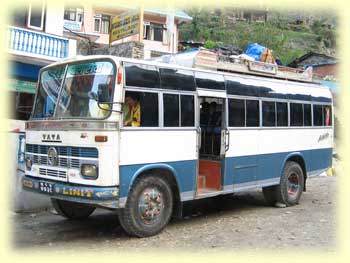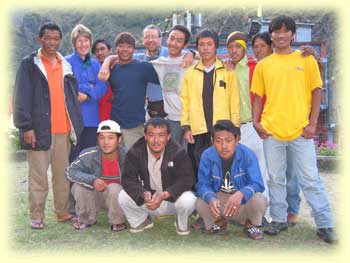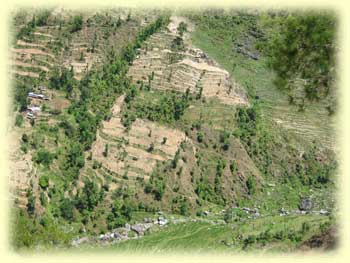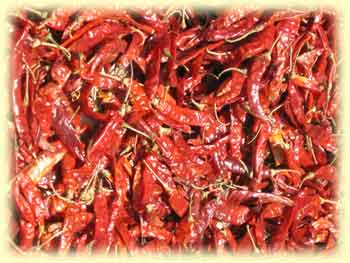|

Wednesday 3rd May 2006
Trek Day 10
Syabru Bensi to Kathmandu
All aboard the 'Magic Bus'

We wake up to a series of noises. First there's the dawn chorus, which, because we are camped near a couple of large trees, is particularly shrill this morning. Then there’s another chorus. This time it’s the local dogs barking, closely followed by an amusing bugle rendition of ‘reveille’, from the nearby army camp. Thus we are awake, and arranging our gear for the long bus journey, well before 5am. Once everything is organised, we emerge from our tent for the last time this trek.
Between the tent and the toilet is a tidy pile of dog poo which is almost as big as the dog that produced it, and I make a mental note to be sure to avoid it. Spending ten hours on a bus with that plastered to the sole of my boots is not something I wish to risk. We are all ready with plenty of time to spare, and because the bus is parked right outside the Buddha hotel where we’ve spent the night, we can take the time to have a leisurely breakfast.
We start to board the bus at ten past six. All the gear is neatly stowed and secured on the roof. The engine roars into life as we take our seats, and without much fuss we are on our way. I look at my watch. It’s exactly six thirty. A more orderly embarkation, I’ve rarely seen in Nepal. It’s usually much more chaotic than this.
 Something that always surprises me is how punctually buses depart in this country. It seems strange that they should insist on leaving on the dot, for a journey that is so unpredictable in nature. The road could be blocked, or washed away. The bus could suffer from any number of mechanical problems, including punctures, broken suspension, and broken axles. There are so many variables, that the journey time could vary by many hours. At least nobody can blame a late departure for any delays in arrival. Something that always surprises me is how punctually buses depart in this country. It seems strange that they should insist on leaving on the dot, for a journey that is so unpredictable in nature. The road could be blocked, or washed away. The bus could suffer from any number of mechanical problems, including punctures, broken suspension, and broken axles. There are so many variables, that the journey time could vary by many hours. At least nobody can blame a late departure for any delays in arrival.
The road out of Syabru Bensi is unsurfaced and rougher than many of the paths we have been walking on. Apart from a short section of tarmac in Dhunche we won’t have a surfaced road until Trishuli. We are sitting in seats numbered six and seven, which are probably the least uncomfortable seats in this short bus. Nevertheless, we are constantly being launched skyward, as the bus grinds its way over the rough track, which my map says is a road!
Dhunche is a little higher in altitude than Syabru, so we make very slow progress. I start to think about what we have let ourselves in for. I’m sure this bus has never been serviced according to the owner’s manual and that, by now, most of its parts have been replaced by fake or home-made versions. Reassuringly, the brakes actually seem to work, although they don’t sound too good when the engine stalls and the driver uses them to prevent us from rolling back down the hill again. Fortunately this road is seriously bad, and we are barely going at the speed of a brisk walk.
We reach the spot where the Landcruiser has broken down, with its axle in pieces, and have to edge past slowly, between it and the steep drop into the valley below. There are scant inches between us and oblivion. As we grind our way towards Dhunche the fear fades and we start to appreciate the spectacular scenery. The Nepalese passengers start to sing, which at first seems nice, until I realise that they might be singing in order to take their minds off the horrors of this narrow mountain track.
 This bus is amazing. At the front, just behind the driver, is a box fixed to the ceiling. On the door of the box, some joker has painted a picture of a TV screen, complete with control knobs, as if we could partake in some form of in-flight entertainment, to while away the hours. Did I say in-flight? This bus is amazing. At the front, just behind the driver, is a box fixed to the ceiling. On the door of the box, some joker has painted a picture of a TV screen, complete with control knobs, as if we could partake in some form of in-flight entertainment, to while away the hours. Did I say in-flight?
The seats are fully adjustable. On the front of the seat there is a large metal knob which you can find if you reach down between your knees. Turning the knob causes the seat to recline or become upright again. The problem is that it takes about ten turns before anything really happens, by which time you realise you’ve been twisting the wrong way. The squab is pretty uncomfortable, especially when you land on it after the bus has launched you up into the air, and the backrest is so loose that it is constantly pummelling your spine. Only another 120km to go!
There are markers along the road showing the distance to Kathmandu, and it seems almost impossible that the total can be diminishing at such a slow rate. The bus stops frequently; every few minutes, it seems. Passing an oncoming vehicle, on the narrow road, is a major manoeuvre, requiring skill and team-work. Each bus has a driver and two bus boys. The driver drives obviously, but this is no ordinary driving, and requires the arms of an Orang-Utan to wrestle with the enormous steering wheel. The road is never straight and the driver is constantly steering us one way or the other.
And the bus boys? Well the bus boys are ticket collectors, indicators, proximity detectors, and mechanics, all rolled into one. In short, you wouldn’t get very far without the bus boys. They’re essential when buses pass each other with only inches to spare. They employ a messaging system which involves slapping the palms of their hands on the sides of the bus. This seems to tell the driver how to progress, and it works perfectly.
 The bus boys also tell the roof passengers when to get down and cram inside the bus, as we pass through the army check-points. This is the other main reason that we are constantly stopping. I lost count of exactly how many check-points we passed through, but it must have been at least a dozen. The bus stops at the barrier and the engine is switched off. All the Nepalese passengers then have to get off and pass through the post on foot. Some are then singled out, seemingly at random, for checking and questioning. As is befitting essentially Asian country, the rules regarding this procedure are a mystery. Not everyone gets off the bus every time, but it’s made clear that we tourists don’t have to participate. I find it all very degrading to the Nepalese and debate whether I should show a bit of solidarity, and walk through with them. I know however, that this would just cause a big fuss and serve no purpose. The soldiers board the bus and make a half hearted search up and down the aisles, and check the overhead luggage racks. It’s all pretty casual really. The bus boys also tell the roof passengers when to get down and cram inside the bus, as we pass through the army check-points. This is the other main reason that we are constantly stopping. I lost count of exactly how many check-points we passed through, but it must have been at least a dozen. The bus stops at the barrier and the engine is switched off. All the Nepalese passengers then have to get off and pass through the post on foot. Some are then singled out, seemingly at random, for checking and questioning. As is befitting essentially Asian country, the rules regarding this procedure are a mystery. Not everyone gets off the bus every time, but it’s made clear that we tourists don’t have to participate. I find it all very degrading to the Nepalese and debate whether I should show a bit of solidarity, and walk through with them. I know however, that this would just cause a big fuss and serve no purpose. The soldiers board the bus and make a half hearted search up and down the aisles, and check the overhead luggage racks. It’s all pretty casual really.
At one of the checkpoints we are also made to get off the bus and have to pay Rp1000 each, for the park fees that we failed to pay in Thulo Syabru. We’d tried to pay, but the office was unmanned. Anyway at least it means that it isn’t just the Nepalese who are suffering on this bus ride, and I start to feel a little less like an over privileged tourist.
We lose a lot of altitude and unless the bus is moving quickly, it starts to get very hot and uncomfortable. The bus rarely moves above a walking pace so we start to bake. The windows are loose in their frames, and the one next to me keeps sliding closed. I consider trying to wedge it open but then realise how impossible that would be, because the whole frame distorts when we go over a bump. Any wedge would just fall out after a few seconds.
I stare out of the window at the passing scenery, and think of all the things we’ve done and experienced over the past couple of weeks. The uncertainty when we departed from Dubai. Our arrival at Kathmandu Airport, and then wondering what we’d let ourselves in for. The soldiers and the roadblocks we found in the streets of the city, and the joy of meeting Nurbu again, after so many years. The feeling of sheer happiness when we started walking on the first day of our trek, and the fun we had with Khukri. The way all the porters and kitchen staff worked so hard to make our lives on the trek so comfortable, and all the people we met up with on the way. These are things we’ll never forget.
Suddenly there is a commotion at the rear of the bus. There is a lot of screaming and shouting and the bus comes to an abrupt halt. I turn around to see a lady in a colourful sari retching in the aisle. Then another woman comes running forward, clutching her child. It turns out that the kid has filled its pants, and the smell has caused a riot amongst those in range. As the woman passes me on her way off the bus, I get to understand why the other passengers have reacted in such a manner! Fortunately the bus has stopped near a stream and it’s a simple matter of dunking the child’s bum in the water until clean.
When you start off on these bus journeys you are all too aware that the whole situation is pretty precarious, and that reaching your destination in one piece, is not a certainty. Fortunately as the journey progresses, this feeling wears off. You just become numb, and resigned to your predicament. A bus journey in Nepal is not for the faint-hearted. Take my word.
Something that never ceases to amaze me is the way in which the younger male passengers are constantly climbing out of the windows, and up onto the roof, while the bus is swaying and clawing its way along the bumpy road. It shouldn’t therefore have been a surprise, when one of them fell off! I’m sitting gazing at the steep hillside when I spot a hat fall down from the roof into the ditch. Then I’m stunned to see its owner, following close behind. It’s one of our porters, and he has landed upside down beside the ditch. My blood turns cold, but to my amazement, he jumps to his feet and runs towards the bus, which has now been brought to a halt. He dusts himself off, and looking more embarrassed than physically hurt, proceeds to climb back onto the roof. Liz wants to check him over, but it’s too late. Presumably he’s in a hurry to get even with whoever pushed him off, and I fully expect someone else to repeat his tumbling act. I hear the sound of jeering and laughter, coming from above, and it appears that all is settled amongst the roof community.
 The bus starts to climb again, away from the river, and I see that the road is running right round a huge bowl in the valley side. This bowl is so large that I can pick out traffic on the lower sections that we passed at least an hour previously. The road leads us into and out of endless side valleys. It eventually takes us up to a pass, before descending into the polluted cauldron of the Kathmandu valley. When we think we are nearly at the end of our journey, there are more check posts and delays. Eventually we pull into a petrol station which turns out to be the bus terminus. The 132km journey has taken us ten hours! It is still daylight. We are hungry and thirsty having survived the whole journey on fruit, nuts and sips of water. We hadn’t fancied suffering full bladders on that bumpy road, or risking food poisoning from one of the roadside restaurants. The bus starts to climb again, away from the river, and I see that the road is running right round a huge bowl in the valley side. This bowl is so large that I can pick out traffic on the lower sections that we passed at least an hour previously. The road leads us into and out of endless side valleys. It eventually takes us up to a pass, before descending into the polluted cauldron of the Kathmandu valley. When we think we are nearly at the end of our journey, there are more check posts and delays. Eventually we pull into a petrol station which turns out to be the bus terminus. The 132km journey has taken us ten hours! It is still daylight. We are hungry and thirsty having survived the whole journey on fruit, nuts and sips of water. We hadn’t fancied suffering full bladders on that bumpy road, or risking food poisoning from one of the roadside restaurants.
We bid farewell to Nurbu and the gang, and take a taxi to our hotel. The driver doesn’t know the way, but hey, who cares when we’ve just survived a ten-hour bus journey. We are just glad to be alive.
We eventually arrive at the hotel to a warm welcome from the staff, and make our way up to our room, for an even more welcome shower. We don’t waste any time before getting cleaned up, into fresh clothes, and out into the town. We’ve both been dreaming of a slap-up meal, washed down with some cold beer, at Ying & Yang’s, our favourite Thai restaurant.
Having spent most of the last ten days in the open, we are reluctant to go inside the restaurant, and so try our luck, sitting out in the garden. We can hear thunder rumbling in the distance, and it soon starts to rain, forcing us to go inside. The meal is wonderful, and the cold beer hits the spot. We leave the restaurant in search of somewhere with live music. Kathmandu used to be full of live music venues, but it takes us some time before we come across a place with a live band. In the old days you had loads of choice of bars with enthusiastic Nepalese rock musicians. Maybe they are now all in Dubai, working the petrol pumps.
The bar we’ve found is pretty empty, and we are two of only six in the audience. Every number performed is announced as being off either the first, second, third or fourth album, as if we should be familiar with their apparently prolific musical catalogue. I have to say that, although unfamiliar, the music is really very good and we soon get into the mood. The band members are not exactly what you’d expect from just listening to the music. The lead singer is obviously the driving force behind the band, and you get to thinking that the rest of the four-piece group, are really only there as a vehicle for his undoubted talent. However, all of them turn out to be good musicians in their own right.
The lead singer is around six-foot tall, with curly grey hair. He looks as if he could be Afro-Caribbean or maybe Tibetan, and is really the only one that looks the part. The rest of the members look just like they’ve just finished a trek. The bass guitarist is short and dumpy with ill-fitting jeans and a lumberjack shirt. The lead guitarist looks like his brother and the drummer his cousin. Despite appearances, you can’t fault their musical ability; they really are a nice tight little band.
We enjoy the music, but eventually the day catches up with us so we pay the bill, and head back to the hotel. On the way out, we bump into the Israeli girl that we met on the trek. When we last saw her, she was suffering from fatigue and sunburn; but now she is full of life, and seems genuinely pleased to see us. We really can’t keep our eyes open, so say our goodbyes, and hurry off back to our room.
<Return to Nepal Page>
© Roy L Richards 2012
Contact for problems, queries etc:
|
Updated Jan 2010
|
|

|
|
|
|

|
|
|





